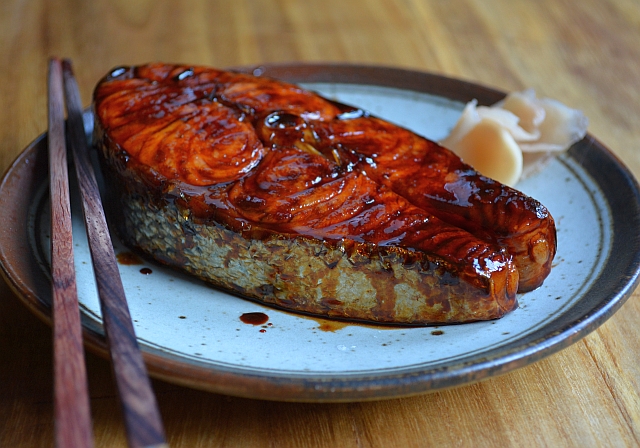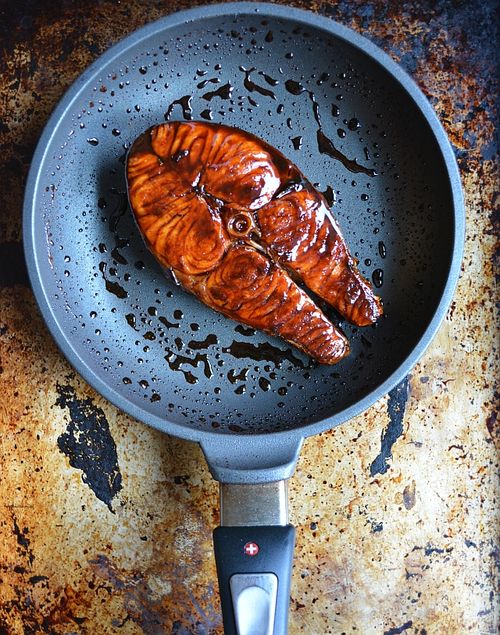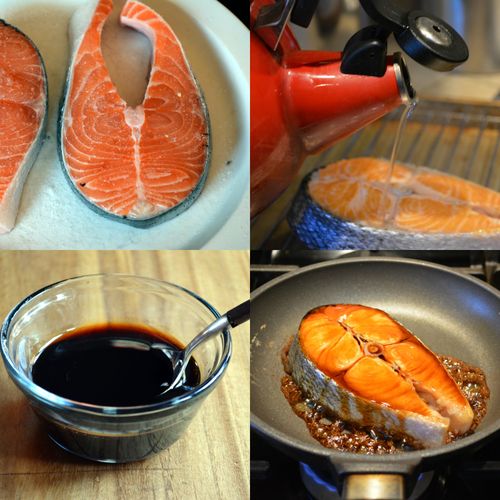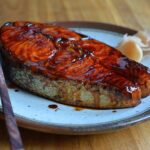
I’ve been meaning to make salmon teriyaki ever since Tamaso and Robert shared their stovetop techniques via the comments on the true chicken teriyaki recipe post. What stopped me from doing it till last week was getting around this issue: lingering fishy smells in the house. I know that sounds weird of me, the person who has no problem deep-frying up a storm. I have a decent exhaust over the stove but it isn’t quite enough. I rarely sear fatty fish like salmon on the stove. A couple of weeks ago after eating at a local restaurant I walked out with a sweater that reeked of pan-seared fish.
When the kitchen fired (cooked) the fish order, I recognized the smell of fish oil hitting the pan, and I remembered long afterward. I was looking for a solution to stinky salmon teriyaki,but the majority of Japanese cookbooks I own called for grilling or broiling the fish; the teriyaki glaze just doesn’t seem to adhere and penetrate well on
the grill or under the broiler. The only work that prescribed stovetop cooking
was Shizuo Tsuji’s Japanese Cooking: A Simple Art. His method was so interesting for several reasons.
Rinse the Fish Twice
In the yellowtail teriyaki recipe, Tsuji called for liberally salting the fish for 30 minutes to remove moisture and firm the flesh, as well as to remove some of the fishiness. The stovetop searing was done in two steps: a partial quick sear followed by – this was the kicker – a quick rinse of boiling water. Seriously. That washed away some of the fishy oiliness and salt, explained Tsuji, who obviously realized how weird that technique was. Then the fish was finished in the skillet with the teriyaki sauce.

His recipe called for using a tiny bit of oil in the pan to prevent sticking. Tsuji warns cooks of the smoke that will rise from the pan. My workaround was to use an 8-inch (20 cm) Swiss diamond nonstick skillet, which is super heavy and conducts heat well. (I bought my "irregular" one for about $35 from this site). I used no oil and the salmon was fine. Because of my small skillet, I cooked the steaks one at a time.
So did the fish stink up the house?
No. There was a faint smell but it was not unpleasant. We had leftovers so I packed some for my husband’s work lunch and ate some at room temperature for my lunch at home. It was delicious.
I used homemade mirin for the teriyaki sauce and served the salmon with some of the pickled ginger prepared weeks ago. It’s pretty neat to cook with pantry items you made yourself, but you don’t have to do like I did to make a good version of salmon teriyaki.
One final note, I opted for salmon steaks in order to glaze the maximum surface area of flesh. Plus, salmon steaks are less expensive than fillet and they taste better. The little ends by the belly of the steaks are fatty and cook up to a delightful rich, savory sweetness. Save that for yourself.
Related recipes:
- True Chicken Teriyaki
- Homemade Mirin
- Homemade Japanese pickled ginger
- Beige Rice: The Middle Path between White and Brown
- How to Cook Perfect Rice
Salmon Teriyaki Recipe
Ingredients
- 2 salmon steaks, each about 10 ounces (300 g) and ¾ inch (2 cm) thick
- ¼ to ½ teaspoon fine sea salt
- 2 tablespoons teriyaki sauce, make from step 1 of the chicken teriyaki recipe (see link above recipe and in Note below)
- Japanese pickled ginger, homemade or storebought
Instructions
- Rinse and pat the salmon steaks dry, putting them on a plate. Sprinkle sea salt all
- over the steaks, letting the salt rain down on the fish. Flip and repeat on the other side. Rub some on the skin too. It's fine for salt to be on the plate. Let sit for a minimum of 30 minutes, or cover and refrigerate for up to 1 ½ hours; return to room temperature before cooking.
- Set a rack placed inside a rimmed baking sheet near the stove. Bring some water to a boil in a kettle on the stove, lowering the heat to keep hot.
- To cook, heat a heavy nonstick skillet over medium-high heat. Lay down the steak(s) and let them sear, undisturbed for 1 ½ minutes. Turn and sear the other side. Transfer to the rack. Return the water to a boil, remove from the heat, and let the boiling subside before pouring some water over the fish to quickly rinse it.
- Flip the fish pour water over the other side.
- Replace the fish in the skillet. Add the teriyaki sauce and 2 tablespoons of water.
- Heat the skillet over medium-low heat. Cook for about 5 minutes longer, turning the fish to coat and glaze the fish with the bubbly sauce. When there's little liquid left in the skillet, the fish is done. If you cooked the steaks one at a
- time, repeat with the other steak. Transfer to a plate and serve with pickled ginger. Rice is the perfect accompaniment.
Notes
- Chicken Teriyaki Recipe (use the sauce from this recipe)
- Homemade Mirin



















Duane says
I have used his recipe for years - and it is great!
Andrea Nguyen says
It's remarkable. I don't know why it didn't catch on more. I don't know why I didn't figure it out sooner! You, though, are a smartie, Duane.
Robyn says
Hi Andrea
When I first lived in Japan in the mid-70s, I hated coming home in the evening, the alleyways reeked of fish being grilled. I also 'held my breath' in order to consume miso soup made with very dark hatcho miso, despite the fact I was in Kyoto, the mother in the home in which I lived hailed from Nagoya. With time I got used to those smells and now of course modern houses don't 'leak' cooking odours as much either. But I understood when Japanese came to NZ and complained of the smell of lamb cooking here.
Cheers, Robyn
Gina says
I once moved into an apartment that had been occupied by an Indian family. The curry smell (which I normally would not mind) was so pervasive that I had to repaint the whole place to get rid of it.
Back to the recipe: couldn't you just marinate the salmon in teriyaki sauce and then broil it in the oven?
Suzette says
Thanks to salted-fish fried rice, I have learned the joys of cooking outside. 🙂
Andrea Nguyen says
Robyn, that is a fabulous story. Cultural relativism. Nature or nurture. How we react to food with our noses and brains is fascinating! Thanks for sharing.
Andrea Nguyen says
The emptied and washed jar that I used to store curry powder had been perfuming my pantry for 2 weeks.
I don't know about your question but my hunch is that the teriyaki sauce may not adhere to the salmon as well. If you try it, would you let us all know? Thanks.
Andrea Nguyen says
OMG -- yes, I so love salted-fish fried rice and honestly, have not made it at home. Greatly appreciate your sharing your *secret*.
Christin says
Yum! This looks so good. I love Salmon Teriyaki. Giving this a try for sure.
Diane says
I am setting up an outdoor wok specifically so I can make salted fish fried rice. I have made it exactly ONCE in my house, and it was horrible! Tasty stuff, but stinks up the place for days.
DanS says
Thanks for sharing the recipe. Great tips on rinsing the salmon with near-boil water!
Erika says
Thank you for these thorough instructions! I tried to make salmon marinated in teriyaki sauce on the stovetop the other day and it was rather tasteless. I'm definitely going to try this method next time!
Erika says
Just to clarify--when you sear the salmon in the first step after letting it sit with the salt, do you put it in an oiled or unoiled pan? I didn't grease the not very high-quality nonstick pan I was using and it stuck quite a bit when I tried to flip it. Some of it came off when I added the teriyaki sauce, but is that correct?